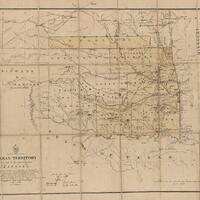 In the Matter of Elizabeth Denison, James Denison, Scipio Denison, and Peter Denison, Jr. (1807) In the Matter of Elizabeth Denison, James Denison, Scipio Denison, and Peter Denison, Jr. (1807) |
|
Elizabeth, James, Scipio, and Peter Denison Jr. filed a writ of habeas corpus, seeking their freedom from Catherine Tucker based on the Northwest Ordinance of 1787 which prohibited slavery in the Northwest Territory. Their enslaver claimed ownership based on Jay's Treaty, which allowed settlers of this territory to hold property of any kind, including enslaved people. While the courts eventually decided in favor of Tucker, the Denisons escaped into Canada, taking advantage of a doctrine that there was no obligation to give up fugitives from a foreign jurisdiction. They eventually returned to Michigan Territory and lived as freedmen.
|
 Indian Territory with Part of the Adjoining State of Kansas &c. (1866) Indian Territory with Part of the Adjoining State of Kansas &c. (1866) |
|
This map shows the treaty-designated territories of the Cherokee, Chickasaw, Choctaw, Muscogee Creek, and Seminole Nations after the conclusion of the Civil War and the signing of each tribe’s 1866 Treaty. Notably, the territories of each nation were significantly reduced.
|
 Matilda v. Isaac Vanbibber (1815) Matilda v. Isaac Vanbibber (1815) |
|
Matilda was a Black girl, aged twelve or thirteen, who was brought into Indiana Territory and later forcibly removed to Missouri Territory and sold as a slave. In her petition for freedom, Matilda argued that she earned her freedom while in Indiana Territory by virtue of the Northwest Ordinance of 1787 which banned slavery in the new territories.
|
 Paul Jones v. George W. Jones (1840) Paul Jones v. George W. Jones (1840) |
|
Paul Jones initiated a suit in a Wisconsin Territory court against George W. Jones for several sums of money owed to him for labor, goods, wares, and merchandise. George argued that Paul was purchased as a slave for life from French inhabitants who were entitled to hold slaves according to the Northwest Ordinance of 1787.
|
 People v. Buffum (1953) People v. Buffum (1953) |
|
One of California's pre-Roe v. Wade abortion cases, the decision in Buffum attempted to regulate abortion tourism to Mexico. This case determined that California could not legislate medical practices in Mexico, causing an increase in abortion clinics across the border in Tijuana.
|
 Platt Amendment (1903) Platt Amendment (1903) |
|
The Platt Amendment was a part of the Army Appropriations Act of 1901 and stipulated conditions of Cuban independence following the Spanish-American war. It laid the foundation of Cuban-U.S. relations for the next several decades.
|
 Royal Proclamation of 1763 Royal Proclamation of 1763 |
|
Following the Treaty of Paris, the Royal Proclamation of 1765 ceded all North American French territory to the British government. The proclamation set up governments for the new British territories. It also limited settlement past a line drawn down the Appalachian Mountains. As a reward to the soldiers who fought in the war, the document also outlines the amount of land soldiers of different ranks were entitled to.
|
 Treaty of Guadalupe Hidalgo (1848) Treaty of Guadalupe Hidalgo (1848) |
|
The Treaty of Guadalupe Hidalgo reset the southern border between Mexico and the United States. Implications of the treaty included issues of citizenship, land, and legal status. Mexican nationals were admitted as U.S. citizens, legally defining them as white, but they could also be regarded as Indian on a case by case basis.
|
 Treaty with the Choctaw and Chickasaw (1866) Treaty with the Choctaw and Chickasaw (1866) |
|
The 1866 Treaty with the Choctaw and Chickasaw was one of a series of treaties between the United States government and each of the "Five Civilized Tribes" (the Cherokee, Chickasaw, Choctaw, Muscogee Creek, and Seminole Nations) at the end of the Civil War. The treaty details the stipulations for the Choctaw and Chickasaw Nations to re-establish their allegiance with the U.S. after allying with the Confederate States of America during the Civil War. Among other provisions, the Choctaw and Chickasaw Treaty of 1866 included articles that outlawed slavery within both nations (except as a punishment for crime), provided a pathway for citizenship and civil rights for the Freedmen of both nations, and ceded lands to the United States.
|
 Undesirable Aliens Act (1929) Undesirable Aliens Act (1929) |
|
This act made unlawfully entering the U.S. a crime for the first time. Immigrants who did not cross the border through an official point of entry, where they had to pay a fee and submit to tests, could be charged with a misdemeanor crime, facing fines and up to a year's imprisonment. Returning to the U.S. after deportation was made a felony, punishable by $1,000 in fines and up to two years imprisonment. This law applied to all immigrants entering the U.S., but was intended to restrict immigration from Mexico.
|
 In the Matter of Elizabeth Denison, James Denison, Scipio Denison, and Peter Denison, Jr. (1807)
In the Matter of Elizabeth Denison, James Denison, Scipio Denison, and Peter Denison, Jr. (1807) Indian Territory with Part of the Adjoining State of Kansas &c. (1866)
Indian Territory with Part of the Adjoining State of Kansas &c. (1866) Matilda v. Isaac Vanbibber (1815)
Matilda v. Isaac Vanbibber (1815) Paul Jones v. George W. Jones (1840)
Paul Jones v. George W. Jones (1840) People v. Buffum (1953)
People v. Buffum (1953) Platt Amendment (1903)
Platt Amendment (1903) Royal Proclamation of 1763
Royal Proclamation of 1763 Treaty of Guadalupe Hidalgo (1848)
Treaty of Guadalupe Hidalgo (1848) Treaty with the Choctaw and Chickasaw (1866)
Treaty with the Choctaw and Chickasaw (1866) Undesirable Aliens Act (1929)
Undesirable Aliens Act (1929)